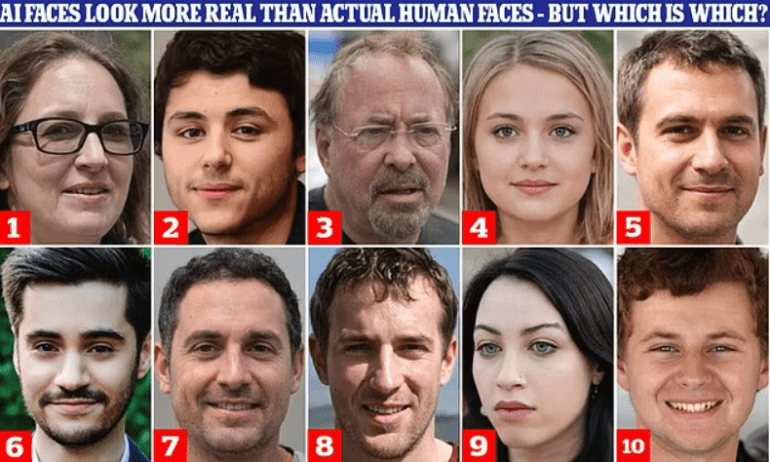TL;DR:
- AI-generated faces now resemble real people to the extent that humans struggle to differentiate between them.
- Research reveals that AI-generated faces are frequently mistaken for human faces, posing risks for misinformation and identity theft.
- Dr. Amy Dawel’s study highlights that white AI faces are often perceived as more authentic than actual human faces.
- The study suggests that tools to identify AI impostors may be necessary.
- Concerns arise regarding racial bias in AI face generation and its potential reinforcement of biases online.
Main AI News:
In the realm of artificial intelligence (AI), a startling revelation has emerged – the uncanny ability of AI to craft counterfeit faces that appear even more authentic than genuine human visages. According to a recent study, the sophistication of AI has reached a point where distinguishing between AI-generated faces and actual individuals has become an increasingly daunting task.
In an intriguing series of experiments conducted with U.S. citizens, it was found that a significant portion of participants consistently mistook AI-generated faces for those of real humans, highlighting the remarkable realism achieved by AI technology. This phenomenon of ‘hyper-realistic’ imagery could potentially serve as a breeding ground for misinformation and identity theft in the online realm, as it enables the creation of convincing and deceptive profiles.
The study in question involved a direct comparison between five AI-generated faces and five human faces. Spearheaded by Dr. Amy Dawel, a cognitive and clinical psychologist at the Australian National University (ANU) in Canberra, the research uncovered that AI faces possessing an uncanny ability to mirror the typical human ideals of physical appearance, thereby confounding human observers.
Dr. Dawel commented on the findings, noting, “It turns out that there are still physical differences between AI and human faces, but people tend to misinterpret them. For example, white AI faces tend to exhibit more proportionate features, leading people to mistake these as signs of genuine humanness. However, we cannot rely on these physical cues for long. AI technology is advancing so rapidly that the distinctions between AI and human faces may soon blur into obscurity.”
To conduct their investigation, Dr. Dawel and her team enlisted the participation of 124 U.S. residents, all of whom were of white ethnicity and aged between 18 and 50. These participants were presented with 100 real human faces and 100 AI-generated faces, produced using the formidable AI tool, StyleGAN2, developed by U.S. firm Nvidia.
The results of the study raised considerable concern, as it was revealed that four out of five faces deemed most human by the participants were, in fact, AI-generated. Conversely, four out of five faces considered most likely to be AI were authentic human faces. This astonishing revelation underscores the level of realism achieved by AI in replicating human features.
The authors of the study emphasized a troubling aspect: “White (but not non-white) AI faces are, remarkably, judged as human more often than pictures of actual humans. We pinpoint the perceptual qualities of faces that contribute to this hyperrealism phenomenon, including facial proportions, familiarity, and memorability.”
Alarmingly, those individuals who confidently asserted that AI-generated faces were genuine humans were themselves the most certain in their judgments. This implies that individuals who mistakenly identify AI-generated imposters as real people remain oblivious to the deception.
Ironically, the responsibility of accurately distinguishing between AI and human faces may soon fall into the hands of machines, as suggested by the authors. Dr. Dawel emphasized, “Given that humans can no longer detect AI faces, society needs tools that can accurately identify AI imposters. Educating people about the perceived realism of AI faces could help make the public appropriately skeptical about the images they encounter online.”
The study’s authors also raised concerns about the potential for racial bias, as AI algorithms are often trained primarily on white faces, potentially making them appear more realistic. This could lead to inaccuracies in the depiction of black faces, though such disparities may render them distinguishable from genuine photographs of black individuals.
Dr. Dawel concluded with a sobering warning, “If white AI faces consistently appear more realistic, this technology could have profound implications for people of color by perpetuating racial biases online. This issue is already evident in existing AI technologies used to create professional-looking headshots, which often alter the skin and eye colors of people of color to match those of white individuals.”
Conclusion:
The advancement of AI technology in creating hyper-realistic faces that surpass human authenticity presents both opportunities and challenges for the market. While this development can be harnessed for various applications, including entertainment and marketing, it also raises significant concerns related to misinformation, identity theft, and racial bias. Businesses need to be aware of these implications and consider strategies for responsibly utilizing AI-generated content while ensuring transparency and accuracy in the digital landscape.

